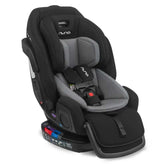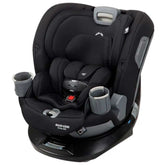Does Baby Have an Ear Infection? Helpful Tips for Parents

Updated 26 Dec 2024
Nearly all children will experience an ear infection before age three – approximately five in six kids, according to the National Institutes of Health. Many parents worry that an ear infection in babies and toddlers could cause permanent hearing loss, but fortunately, that’s not usually the case. Most infections resolve on their own or heal quickly with simple treatment options.
What Causes Ear Infections in Babies and Toddlers
Ear infections in babies are often triggered by a sore throat, a cold, or a respiratory infection. Bacteria and viruses reach the middle ear via the eustachian tube. The eustachian tube connects the back of the throat to the middle ear. In a healthy individual, this tube allows fluid build-up from the ear to drain away. If the tube is inflamed and swollen from infection, however, it can become clogged, trapping fluid and bacteria and causing pain. Compounding the problem is the fact that babies and toddlers have shorter, less angled eustachian tubes than adults, making them far more prone to inflammation and infection. They also have underdeveloped immune systems that are less prepared to stave off infection. For some children, this middle ear can stay blocked for extended periods of time or swell repeatedly, even when there’s no infection.
Can Ear Infections Be Caused By Teething?
No, teething does not cause ear infections, according to ENT & Sleep Specialists. Again, ear infections are the result of a viral or bacterial infection. Teething is a separate process. That being said, it's certainly possible for children to be teething and have an ear infection at the same time. This can make it hard for parents to determine whether the pain or discomfort is caused from teething or an infection.
Signs and Symptoms of Ear Infection in Baby: How Do You Know If a Baby Has an Ear Infection?
One of the biggest signs of an ear infection in baby is pain inside and around the ear. Since many little ones suffering this particular type of discomfort aren’t even old enough to talk and explain what’s hurting, parents and caregivers are often left trying to figure it out on their own. Here are a few good indicators that you may be dealing with an ear infection:
- Your baby is pulling or rubbing their ears.
- Baby has trouble sleeping. The pressure from lying down may worsen the pain.
- Your child isn’t hungry. Bottle feedings can cause pressure in the middle ear as the baby swallows, triggering more discomfort and an urge to stop eating.
- Baby cries a lot or seems especially irritable.
- They’re running a fever. Ear infections can cause temperatures from 100° F up to 104° F. About half of all kids will experience fever with ear infections.
- Yellow, brown, or white fluid is draining from the ear. This could be an indication of a ruptured eardrum.
- They have difficulty hearing. The bones inside the middle ear attach to the nerves that transmit electrical signals (as sound) to the brain. Trapped fluid can restrict the movement of these electrical signals through the inner ear bones.
If your child is experiencing a high fever, extreme pain, or bloody or pus-like drainage from the ears, seek immediate medical attention.

Ear Infection Treatments: How Can I Treat My Baby's Ear Infection at Home?
Most ear infections resolve on their own without the need for antibiotics. If you suspect your baby has an ear infection but doesn’t appear to be experiencing extreme discomfort, your pediatrician may recommend a “wait-and-see” strategy along with over-the-counter pain relievers. One reason doctors have moved to this approach is that overuse of antibiotics may cause the bacteria triggering the ear infections to become antibiotic-resistant, making future treatment more challenging. In most cases, antibiotics aren’t needed anyway.
The American Academy of Pediatrics (AAP) has made the following recommendations for when to prescribe antibiotics and when to consider waiting based on the child’s age, the severity of the infection, and the child’s temperature.
Younger than 6 months
Babies younger than six months nearly always receive antibiotics. Complications can be more severe in very young babies, and at this age, they have not been fully vaccinated and lack extra immune system protection. Bacteria trapped in the middle ear can disperse to other parts of the body and induce further infection.
Babies aged 6 months to 2 years
For little ones between the ages of six months and two years, the AAP advises shared decision-making between caregivers and pediatricians about whether to treat ear infections that are not painful. The soundest course of action is typically to observe the child for about three days prior to prescribing antibiotics. If the child is experiencing extreme discomfort or if the ear infection seems to be progressing, your pediatrician may advise prompt antibiotic treatment.
Older than 2 years
For toddlers older than two years, mild ear infections will probably resolve on their own without antibiotic intervention. Your pediatrician may recommend over-the-counter pain relievers, like ibuprofen or acetaminophen to manage any discomfort. If they’re not feeling better after two to three days, antibiotics may be necessary.
Sadly, some little ones deal with recurrent ear infections, up to five or six annually. Children who have repeated infections may be helped by ear tube insertion, a surgical procedure in which small tubes are placed in the eardrums to improve airflow and prevent fluid accumulation.

How to Prevent Ear Infections in Babies
There are a number of ways you can minimize your child’s chances of developing an ear infection.
- Feed your baby breast milk, if possible. Breast milk is loaded with lots of natural antibodies that may help minimize the risk of ear infections and many other illnesses. Whether feeding from a bottle or the breast, try to make sure your little one sits upright during feedings to reduce the chance of fluid flowing into the middle ear.
- Immunize your baby. Babies and toddlers who are current on the recommended vaccinations tend to get fewer ear infections than unvaccinated children. The 13-valent pneumococcal conjugate vaccine (PCV13), for example, protects against 13 types of infection-causing bacteria.
- Practice good hygiene. Washing your hands frequently with soap and water for a full 20 seconds each time is one of the best ways to protect your little one from cold and flu. Keep your child away from sick children or adults when possible.
- Steer clear of secondhand smoke. Research indicates that kids exposed to secondhand smoke are up to three times more likely to develop ear infections than those who don't have those exposures.
The Takeaway on Ear Infections in Babies
Ear infections are a common reason babies and toddlers visit the pediatrician. Ear infections happen when bacteria or viruses infect and trap fluid behind the eardrum, causing pain and inflammation of the eardrum. Most ear infections typically resolve on their own without treatment but may require antibiotics or pain-relieving medications based on the child’s age, fever, and severity of infection.
Disclaimer: The information on our site is NOT medical advice for any specific person or condition. It is only meant as general information. If you have any medical questions or concerns about your child or yourself, please contact your healthcare provider.










